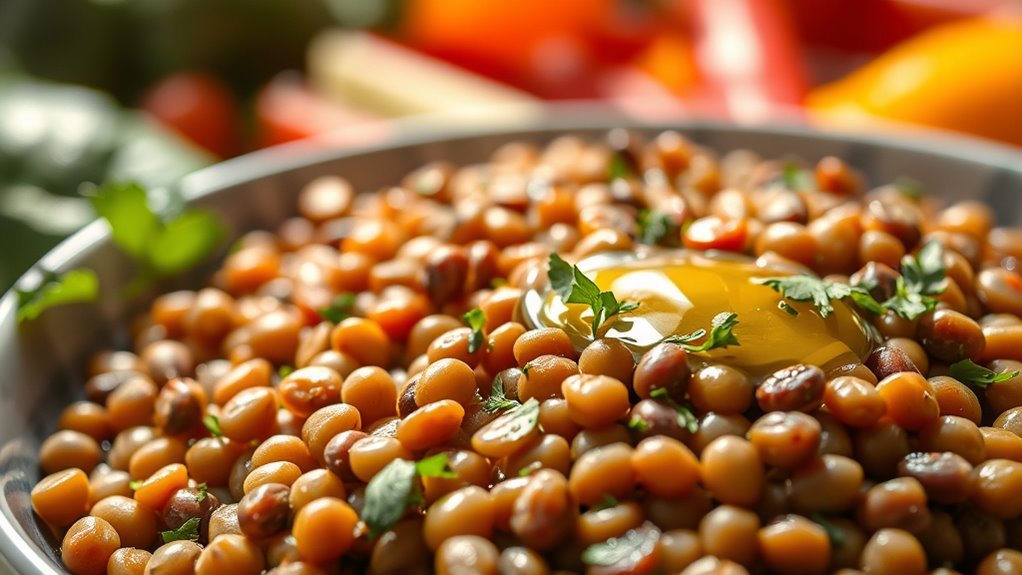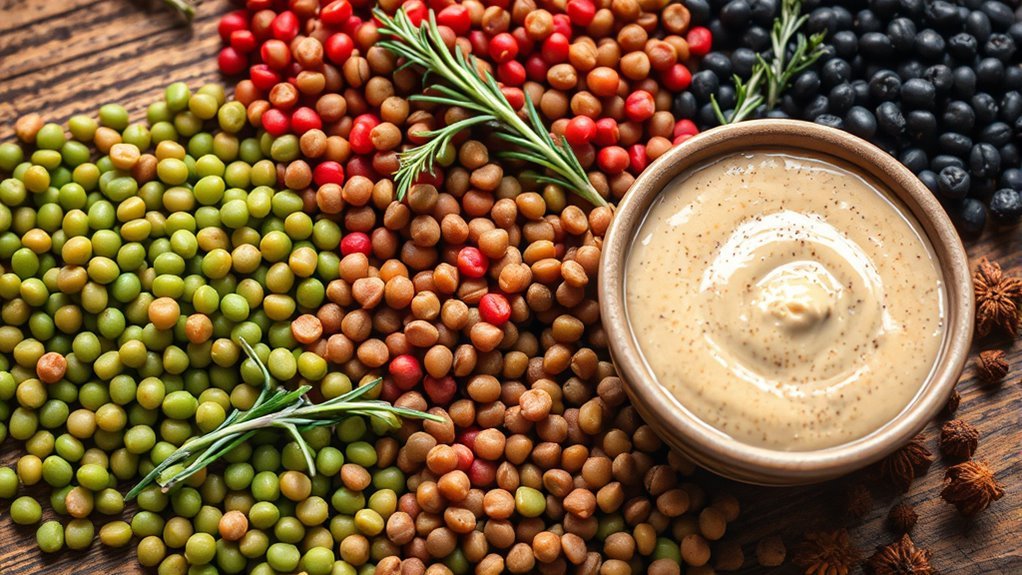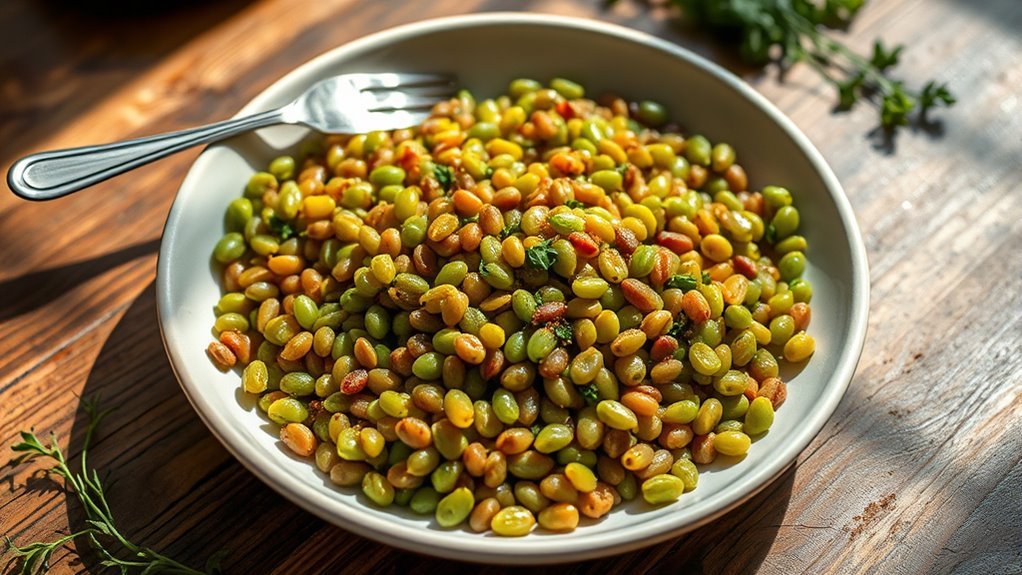Lentils aren’t typically considered keto-friendly due to their relatively high carbohydrate content, with about 20 grams of carbs per cooked cup. While they offer impressive protein and nutritional benefits, fitting them into a strict keto diet can be challenging. Portion control is essential if you choose to include lentils, as monitoring your net carb intake will help you stay in ketosis. To explore alternative options and recipes, keep going, and you’ll discover more insights!
Understanding the Ketogenic Diet

When it comes to understanding the ketogenic diet, it’s vital to grasp its core principles. This diet primarily focuses on macronutrient ratios that emphasize low carbohydrates, moderate protein, and high fat intake. Typically, the goal is to consume about 70% of your daily calories from fats, 20% from protein, and only 10% from carbohydrates. This shift in macronutrient ratios encourages your body to enter a state of ketosis, where it burns fat for energy instead of glucose. Adopting a ketogenic lifestyle can empower you to make informed food choices, ultimately giving you more freedom in your dietary decisions. Remember, though, that individual responses to the diet can vary, so it’s essential to monitor how your body reacts to these changes.
Nutritional Profile of Lentils

While lentils are often praised for their health benefits, understanding their nutritional profile is essential, especially for those following a ketogenic diet. Lentils come in various varieties, like green, red, and black, each with unique flavors and textures. What’s particularly notable is their high protein content, with about 18 grams of protein per cooked cup. This makes them a great option for those seeking plant-based protein sources. However, it’s important to remember that, despite their nutritional benefits, lentils are still relatively high in carbohydrates. If you’re aiming to maintain a strict keto lifestyle, balancing your intake of lentils with other low-carb foods can help you stay within your desired macros while still enjoying their nutrition.
Carbohydrate Content in Lentils

When considering lentils on a keto diet, it’s essential to understand their carbohydrate content, particularly net carbs, which are the total carbs minus fiber. The impact of serving size can meaningfully alter your carb intake, so knowing how much you’re consuming is key. By keeping these factors in mind, you can better assess whether lentils fit into your dietary goals.
Net Carbs Explained
Understanding net carbs is essential for anyone following a keto diet, especially when considering foods like lentils. The net carb calculation involves subtracting fiber from the total carbohydrates, as fiber doesn’t raise blood sugar levels. Lentils contain roughly 20 grams of carbohydrates per cooked cup, but with about 8 grams of fiber, their net carbs drop to around 12 grams. This is vital for your keto diet considerations, as staying within your carb limits is key to maintaining ketosis. While lentils offer protein and nutrients, their net carbs can add up quickly if you’re not mindful. Balancing your meals with low-carb options will help you enjoy the benefits of lentils without compromising your keto goals.
Serving Size Impact
Although you might enjoy the nutritional benefits of lentils, it’s important to contemplate how serving sizes can considerably impact their carbohydrate content. Practicing portion control can help you stay aligned with your dietary goals, especially on a keto diet.
| Serving Size | Carbohydrates (g) |
|---|---|
| 1/4 cup cooked | 10 |
| 1/2 cup cooked | 20 |
| 1 cup cooked | 40 |
As you can see, even a small increase in serving sizes can lead to a significant rise in carbs. Being mindful of your portions allows you to savor the benefits of lentils while keeping your carb intake in check. Remember, enjoying lentils is possible; just pay attention to those serving sizes!
Comparing Lentils to Other Legumes
While lentils are often hailed for their nutritional benefits, comparing them to other legumes reveals a nuanced picture of their carbohydrate content and overall suitability for a ketogenic diet. When you look at legume comparisons, you’ll find that lentils generally contain fewer carbohydrates than chickpeas or black beans, making them a better choice for those aiming to stay within keto limits. However, nutritional variations exist; for instance, kidney beans also offer a rich protein profile but come with higher carbs. If you’re on a keto journey, consider the total carb count and fiber content of each legume. Ultimately, understanding these differences can help you make informed choices that align with your dietary goals while enjoying the diversity of legumes.
Health Benefits of Lentils
Lentils not only stand out among legumes for their lower carbohydrate content but also pack a punch regarding health benefits. These nutrient-dense foods offer impressive protein content, making them an excellent choice for those seeking plant-based protein sources. In addition to their protein benefits, lentils are rich in essential vitamins and minerals, contributing to their overall nutritional value. They’re also linked to various health advantages, including improved heart health, better blood sugar control, and even weight management. By incorporating lentils into your diet, you’ll enjoy a fulfilling and versatile food that supports your health goals. Whether in soups, salads, or stews, the lentil benefits are undeniable, providing you with a delicious way to nourish your body.
The Role of Fiber in a Keto Diet
When starting on a keto diet, understanding the role of fiber is important for maintaining digestive health and overall well-being. Fiber benefits you by promoting regular bowel movements, reducing bloating, and supporting gut health. While keto is typically low in carbs, it’s essential to include fiber-rich foods like leafy greens, avocados, and chia seeds. These foods can help you feel full and satisfied, making it easier to stick to your diet. Plus, fiber helps stabilize blood sugar levels, which is crucial for your energy and mood. Remember, not all carbs are created equal; focusing on high-fiber options can provide you with the nutrients you need without derailing your keto goals. Prioritizing fiber is key to a balanced, sustainable approach.
Portion Control and Serving Sizes
Understanding portion control and serving sizes is essential for anyone maneuvering a keto diet. Even though lentils are nutritious, their carbohydrate content can impact your daily limits. To maintain ketosis, you’ll want to carefully measure your servings. A typical serving suggestion for lentils is about 1/4 cup cooked, which provides around 10-15 grams of carbs. Balancing this with your other meals throughout the day is key. Consider incorporating a variety of low-carb vegetables to fill your plate, allowing you to enjoy the benefits of fiber without exceeding your carb limits. By practicing portion control and being mindful of serving sizes, you can enjoy lentils occasionally while staying true to your keto goals.
Alternatives to Lentils on a Keto Diet
If you’re looking for alternatives to lentils on a keto diet, there are plenty of options to evaluate. Low-carb beans, nut-based protein sources, and various vegetables can provide similar nutritional benefits while keeping your carb intake in check. Exploring these alternatives can help you maintain a balanced diet without sacrificing flavor or satisfaction.
Low-Carb Bean Options
Although lentils are often praised for their nutritional benefits, they can be higher in carbs than what’s typically allowed on a keto diet. If you’re seeking low-carb options, consider these bean alternatives that fit better into your meal plan:
| Bean Alternative | Net Carbs (per 100g) |
|---|---|
| Black Soybeans | 1.5g |
| Edamame (Fresh) | 3.3g |
| Green Beans | 3.6g |
| Lima Beans | 7g |
These options provide a good source of protein while keeping your carb intake in check. By incorporating these low-carb bean alternatives, you’ll maintain the freedom to enjoy flavorful dishes without compromising your keto goals.
Nut-Based Protein Sources
When seeking alternatives to lentils on a keto diet, consider incorporating nut-based protein sources that not only provide essential nutrients but also keep your carbohydrate intake low. Nuts like almonds, walnuts, and pecans offer a great source of nut protein while being rich in healthy fats. For instance, a serving of almonds contains about 6 grams of protein and only 2 grams of net carbs, making it a perfect fit for your keto lifestyle. Additionally, these nuts contain plant protein, essential vitamins, and minerals that support overall health. You can enjoy them as snacks, added to salads, or blended into nut butter. By choosing these nut-based options, you can satisfy your protein needs while maintaining your keto journey.
Vegetable Alternatives to Lentils
While lentils are often praised for their high protein and fiber content, they may not be the best choice for those following a keto diet due to their relatively high carbohydrate levels. Luckily, there are plenty of vegetable alternatives that can fit seamlessly into your meals. Zucchini noodles make a fantastic pasta substitute, while cauliflower rice can serve as a low-carb grain alternative. You might enjoy filling mushroom caps with savory ingredients, or tossing together fresh spinach salads for a nutrient-packed side. Broccoli mash offers a creamy, satisfying option, and eggplant slices can be grilled or baked for added texture. These alternatives not only align with keto guidelines but also provide a variety of flavors and nutrients to keep your meals exciting.
Recipes Incorporating Lentils for Keto
If you’re looking to incorporate lentils into your keto meal plan, it’s important to evaluate their carbohydrate content carefully. While traditional recipes may not always align with keto guidelines, you can creatively adapt them. For instance, try a hearty lentil soup with spices to add flavor without excess carbs. Lentil curry can be rich and satisfying, just watch the portion size. Or whip up lentil burgers for a protein-packed meal. Lentil tacos make a fun twist for taco night, while lentil casserole can be a comforting dish. Don’t forget about lentil dip for a snack! Explore lentil pasta or create lentil bowls topped with low-carb veggies for a filling option that aligns with your lifestyle.
Final Thoughts on Lentils and Keto Compatibility
Incorporating lentils into a keto meal plan requires careful consideration of their carbohydrate content. While lentils offer numerous health benefits, such as high protein and fiber, their carb count can conflict with strict keto guidelines. Many people have misconceptions about keto, believing they can consume unlimited carbs and still achieve ketosis. If you’re aiming for this low-carb lifestyle, it’s important to monitor your lentil intake closely. You might enjoy their nutritional advantages by using them sparingly in your meals or choosing smaller portions. Remember, moderation is key. Ultimately, it’s about finding a balance that works for you, allowing you to enjoy lentils while respecting your keto goals. Always prioritize your health and well-being in your dietary choices.


